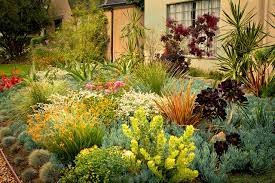I. Introduction
In the face of changing climate patterns and increasing water scarcity, landscaping with drought-tolerant plants has become a smart and sustainable choice for homeowners. Not only do these plants thrive in arid conditions, but they also reduce water consumption and maintenance efforts. This guide will explore the benefits of drought-tolerant landscaping and offer practical tips for incorporating these resilient plants into your outdoor space.
II. Benefits of Drought-Tolerant Landscaping
Water Conservation: The primary advantage of drought-tolerant landscaping is water conservation. These plants are adapted to survive with minimal water, making them an eco-friendly choice in regions where water resources are limited or subject to restrictions.
Lower Maintenance: Drought-tolerant plants typically require less maintenance than traditional landscaping. Their ability to thrive in arid conditions means less frequent watering, reduced need for fertilizers, and minimal pest control measures.
Sustainability: By choosing plants that are well-suited to the local climate, you contribute to the overall sustainability of your landscape. Drought-tolerant landscaping promotes biodiversity and supports the local ecosystem by providing habitats for native wildlife.
Cost Savings: Reduced water usage and lower maintenance needs translate to cost savings for homeowners. As water bills decrease and the need for landscaping services diminishes, you can enjoy a beautiful and sustainable outdoor space without breaking the bank.
III. Selecting Drought-Tolerant Plants
Native Plants: Consider incorporating native plants into your landscape design. These plants have evolved to thrive in the local climate and soil conditions, making them naturally resistant to drought.
Succulents and Cacti: Succulents and cacti are iconic choices for drought-tolerant landscaping. Their unique shapes and textures add visual interest to your garden while requiring minimal water.
Grasses and Groundcovers: Opt for drought-tolerant grasses and groundcovers to create a lush, low-maintenance lawn alternative. Buffalo grass, blue fescue, and creeping thyme are excellent choices.
Perennials and Shrubs: Choose perennials and shrubs that are known for their drought resistance. Lavender, rosemary, and yarrow are not only hardy but also bring delightful fragrances to your garden.
IV. Designing a Drought-Tolerant Landscape
Grouping Plants by Water Needs: When planning your landscape, group plants with similar water requirements together. This allows for more efficient irrigation, ensuring that each plant receives the appropriate amount of water without overwatering others.
Mulching: Apply a layer of mulch around plants to conserve soil moisture. Mulch acts as a barrier, preventing water evaporation and suppressing weed growth. Use organic mulches like bark chips or straw for added benefits.
Efficient Irrigation Systems: Invest in efficient irrigation systems such as drip irrigation or soaker hoses. These methods deliver water directly to the plant’s root zone, minimizing wastage and maximizing water absorption.
Rainwater Harvesting: Consider implementing rainwater harvesting systems to collect and store rainwater for later use. This sustainable practice provides an additional water source for your landscape during dry periods.
V. Maintenance Tips
Pruning and Deadheading: Regular pruning and deadheading help maintain the health and appearance of your drought-tolerant plants. Remove dead or damaged growth to encourage new growth and flowering.
Soil Amendments: Improve soil quality by incorporating organic matter like compost. Well-amended soil retains moisture more effectively, supporting the water-retention capabilities of drought-tolerant plants.
Monitor Plant Health: Keep an eye on the health of your plants. Look for signs of stress, pests, or diseases. Early detection allows for prompt intervention, ensuring the longevity of your drought-tolerant landscape.
VI. Conclusion
Landscaping with drought-tolerant plants is a sustainable and visually appealing choice for homeowners seeking resilient outdoor spaces. By selecting the right plants, designing thoughtfully, and implementing efficient irrigation, you can create a landscape that not only conserves water but also thrives in the face of changing environmental conditions.
FAQs
Q: Can I have a colorful garden with drought-tolerant plants? A: Absolutely! Many drought-tolerant plants offer vibrant colors and diverse textures. Explore options such as lantana, salvia, and penstemon for a colorful and water-wise garden.
Q: Can I use drought-tolerant plants in regions with occasional heavy rainfall? A: Yes, many drought-tolerant plants are adaptable to different conditions. However, proper drainage is essential to prevent waterlogged soil, especially in periods of heavy rainfall.
Q: Are there specific landscaping styles that work well with drought-tolerant plants? A: Drought-tolerant plants can be incorporated into various landscaping styles, from Mediterranean and desert-inspired designs to modern and eclectic layouts. Their versatility allows for creative and personalized landscape designs.
Q: How can I attract pollinators to my drought-tolerant garden? A: Choose flowering plants that attract pollinators, such as bees and butterflies. Lavender, coneflowers, and salvia are popular choices. Providing a water source, like a small birdbath, can also attract birds to your garden.
Q: Can I use mulch in a xeriscape garden? A: Yes, mulch is a beneficial addition to xeriscape gardens. It helps conserve soil moisture, suppress weeds, and regulate soil temperature. Choose organic mulches that break down over time, contributing to soil health.
Source Links:













